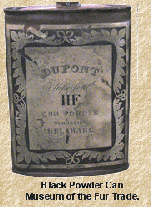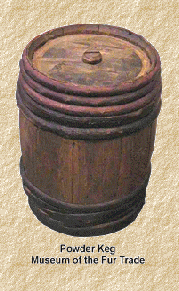Subject Guide

Mountain West
Malachite’s Big Hole


Gun powder was shipped to trading posts and forts in wooden kegs, most often 50-pound size, but also in 25, 12½, and 6¼ pound sizes. Kegs of powder, however, were difficult for individual trappers to manage while in the field. Shown at right is a 25-pound powder keg. Most mountain men seemed to prefer one-pound metal canisters of powder. At left is a powder tin of "DuPont" . These containers were durable, easy to pack and nearly waterproof.
Black Powder:
Black Powder was known and used in China and Europe as early as the 13th Century. The effectiveness of black powder as a propellant is due to the extremely rapid change in state from a small volume of solid powder to a very large volume of gas on ignition. Black powder is a mechanical mixture of three chemicals, carbon, in the form of charcoal, saltpeter, or potassium nitrate, and sulfur. The most common formulation is approximately 75 percent saltpeter, 15 percent charcoal and 10 percent sulfur. Charcoal provides the fuel while the saltpeter acts as an oxidizer. The purpose of the sulfur is to modulate the burning and to enhance the generation of gasses. With most black powders, only about 45 percent of the mass is converted to gas, the remainder being ejected from the muzzle as a solid residue.
The safest manufacturing process involved grinding the individual components to extremely fine powders. The powders were then mixed along with water to form a slurry, which was then shaped into cakes and allowed to dry. After drying the cakes were broken, followed by grinding into appropriately sized granules for use with firearms. (A more complete description of manufacturing process from about 1700 through the end of the 1800's can be found here)
Although the manufacturing process is apparently simple, safely producing black powder is fraught with danger. Very few individuals, even in the fiercely independent "do everything yourself" frontier lifestyle, were willing to undertake the risks associated with the manufacture of black powder, rather leaving the dangers to manufacturing specialists. Even transporting black powder in quantity could be dangerous. For more on freighting gun powder follow this link. In March of 1823, three of William Ashley's men were killed on the outskirts of St. Louis when the wagon in which they were hauling 300 pounds of powder blew up. Samuel Hawken describes this event in his memoirs here.
The finest grained black powder is FFFFg and is used for priming flintlock mechanisms and for use in ignition trains for cannon. FFFg is used for small pistols and small shotguns. FFg and Fg are used for large pistols, and for small and large bore rifles and muskets. The “g” stands for glazed.